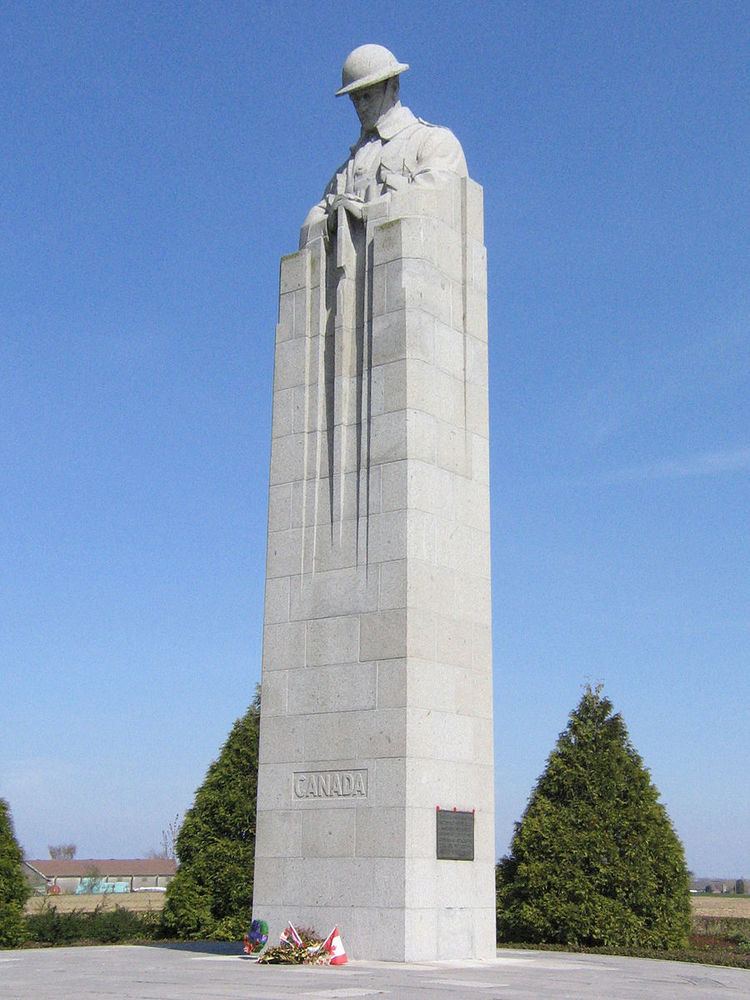Unveiled 8 July 1923 | ||
 | ||
Designed by Frederick Chapman Clemesha Similar Hill 62 Memorial, Tyne Cot, Canadian National Vimy Me, Island of Ireland Peace Park, Menin Gate | ||
The St. Julien Memorial is a Canadian war memorial and small commemorative park located in the village of Saint-Julien, Langemark (West Flemish: Sint-Juliaan), Belgium. The memorial commemorates the Canadian First Division's participation in the Second Battle of Ypres of World War I which included the defence against the first poison gas attacks along the Western Front. Frederick Chapman Clemesha's sculpture, the Brooding Soldier, was selected to serve as the central feature of the monument following a design competition organized by the Canadian Battlefield Monument Commission in 1920.
Contents
Background
The village of Saint Julien and a section of forested land called Saint Julien Wood was at a pronounced bend in the north east sector of the Ypres Salient prior to the Second Battle of Ypres. The area was also the junction between the British and French sectors of responsibility. The Canadian First Division was assigned the most northern section of the British line and to their left, the 45th (Algerian) Division held the southernmost end of the French line. The German Army had brought forward 168 tons of chlorine gas deployed in 5,730 cylinders buried in front of their trenches, opposite Langemark-Poelkapelle, north of Ypres. The Canadians, who had been moved into their positions only a few days earlier were manning the lines for several hundred metres along a front to the southwest of St. Julien when the German Army unleashed the first poison gas attack on the Western Front on 22 April 1915.
Pushed towards the Allied lines by a wind from the north, the initial gas attack largely drifted to the north and west of the Canadian lines, into the trenches of the French colonial troops of the French 45th (Algerian) and 87th (Territorial) Divisions, of 26th Reserve Corps. The gas drifted across positions largely held French colonial troops who broke ranks and abandoned their trenches after witnessing the early casualties, creating an 8,000 yard (7 km) gap in the Allied line. The German infantry were also wary of the gas and, lacking reinforcements, failed to exploit the break before the First Canadian Division and assorted French troops reformed the line in scattered, hastily prepared positions 1,000 to 3,000 yards apart. In actions at Kitcheners Wood, Mauser Ridge, Pilkem Ridge and Gravenstafel Ridge the Canadians held the line and prevented a German breakthrough until they were relieved by reinforcements on the 24 April.
In the 48 crucial hours that they held the line, 6,035 Canadians - or one man in every three who went into battle - became casualties; of that number, approximately 2,000 (or one man in every nine) were killed.
Site and design selection
At the end of the war, The Imperial War Graves Commission granted Canada 8 sites, 5 in France and 3 in Belgium, on which to erect memorials. Each site represented a significant Canadian engagement and for this reason it was originally decided that each battlefield would be treated equally and graced with identical monuments. The Canadian Battlefields Memorials Commission was formed in November 1920 to discuss the process and conditions for holding a memorial competition for the European sites. In October 1922, the submission of Toronto sculptor and designer Walter Seymour Allward was selected as the winner of the competition, and the submission of Frederick Chapman Clemesha placing second. The commission selected Vimy Ridge in France as the preferred site of Allward's design. Clemesha's Brooding Soldier design was selected for the remaining sites but was later, for a number of reasons, erected only at St. Julien in Belgium. The rest of the monuments at Passchendaele and Hill 62 in Belgium as well as Bourlon Wood, Courcelette, Dury and Le Quesnel in France each received an identical, simple 'granite block' memorial which were inscribed with a brief passage describing the battle they commemorate.
The memorial at Saint Julien was unveiled on 8 July 1923 by Prince Arthur, the Duke of Connaught and the tribute was made by French Marshal Ferdinand Foch, former Supreme Commander of the Allied Powers on the Western Front. In his address, Foch stated;
The Canadians paid heavily for their sacrifice and the corner of earth on which this Memorial of gratitude and piety rises has been bathed in their blood. They wrote here the first page in that Book of Glory which is the history of their participation in the war.
After their completion in the mid-1920s, the sites became links in a chain of memorials that included 900+ Commonwealth cemeteries, making a road of remembrance or via dolorosa.
Design and location
The memorial is found on the northern fringe of the village of Saint Julien at the intersection of the N313 road and Zonnebekestrat. During the war, the location where the memorial is located was known as Vancouver Corner. Visible for miles around, the memorial stands 11 metres tall. The 'Brooding Soldier' column rises from a low circular flagstone terrace and is sculpted at its top to form the bowed head and shoulders of a Canadian soldier, his hands resting on his reversed rifle. The column and central terrace is surrounded by gardens of tall cedars trimmed into the shape of artillery shells and low cut cedars trimmed to look like shell explosions. Some of the soil that nourishes the gardens of the memorial was brought from various locations all across Canada to represent the broad spectrum of Canadian men who fought shoulder to shoulder on the battlefields of 1915.
A replica of Clemesha's St-Julien monument was incorporated into the cenotaph designed by R. W. G. Heughan which was erected in Victoria Park, Regina, Saskatchewan, Canada in 1926.
